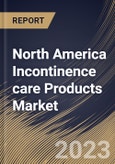Incontinence care products include embedded sensors that detect moisture levels, provide real-time alerts to caregivers or individuals, and track urinary patterns. Smart diapers are particularly useful for elderly care and pediatrics. Innovations in wearable technology have led to discreet and comfortable absorbent briefs with moisture sensors. These briefs can alert users or caregivers when they need changing. Modern moisture-wicking fabrics are used in incontinence devices to drain moisture away from the skin and keep the user dry and comfortable. This innovation helps prevent skin irritation and discomfort.
In addition, products with advanced Odor control technology are designed to neutralize Odors, providing users with increased confidence and comfort. These technologies often involve the use of activated charcoal or other absorbents. The demand for eco-friendly incontinence care products is growing. Innovations include biodegradable, compostable, or reusable products from sustainable materials like bamboo fibers or organic cotton. Advances in manufacturing technology enable the creation of incontinence products tailored to individual needs. Customized products may vary in absorbency, size, and design to cater to specific user requirements.
North America, including the United States and Canada, is experiencing a notable demographic shift, with a growing proportion of its population entering the senior age group (typically defined as 65 years and older). This trend is expected to continue for several decades. Likewise, the number of people with chronic illnesses is rising quickly in the United States. One-third of all fatalities in America - or more than 877,500 people yearly - are caused by heart disease or stroke. These illnesses financially impact the health care system of $216 billion annually. More than 37 million Americans have diabetes, and an additional 96 million adults in the country have prediabetes, which elevates their risk of developing type 2 diabetes. The regional market is expected to expand due to these factors.
The US market dominated the North America Incontinence Care Products Market by Country in 2022 and would continue to be a dominant market till 2030; thereby, achieving a market value of $3,896.3 million by 2030. The Canada market is experiencing a CAGR of 8.1% during (2023 - 2030). Additionally, The Mexico market would exhibit a CAGR of 7.2% during (2023 - 2030).
Based on Usage, the market is segmented into Disposable, and Reusable. Based on Gender, the market is segmented into Female, and Male. Based on Distribution Channel, the market is segmented into Retail Pharmacies, Hospital Pharmacies, and Online Pharmacies. Based on End-use, the market is segmented into Home-patients, Hospitals & ASC's, and Others. Based on Product Type, the market is segmented into Absorbents (Pads & Guards, Underwear & Briefs, Bed Protectors, and Others), and Non-absorbents (Catheters, Drainage Bags, Stimulation Devices, and Others). Based on countries, the market is segmented into U.S., Mexico, Canada, and Rest of North America.
The market research report covers the analysis of key stake holders of the market. Key companies profiled in the report include Essity AB, The procter & Gamble Company, Kimberly-Clark Corporation, Hartmann Group (Paul Hartmann AG), Ontex BV, Domtar, Inc., ConvaTec Group Plc, Hollister, Inc., Coloplast Group, Wellspect Healthcare AB
Scope of the Study
Market Segments Covered in the Report:
By Usage (Volume, Million Units, USD Million, 2019-2030)- Disposable
- Reusable
- Female
- Male
- Retail Pharmacies
- Hospital Pharmacies
- Online Pharmacies
- Home-patients
- Hospitals & ASC's
- Others
- Absorbents
- Pads & Guards
- Underwear & Briefs
- Bed Protectors
- Others
- Non-absorbents
- Catheters
- Drainage Bags
- Stimulation Devices
- Others
- US
- Canada
- Mexico
- Rest of North America
Key Market Players
List of Companies Profiled in the Report:
- Essity AB
- The procter & Gamble Company
- Kimberly-Clark Corporation
- Hartmann Group (Paul Hartmann AG)
- Ontex BV
- Domtar, Inc.
- ConvaTec Group Plc
- Hollister, Inc.
- Coloplast Group
- Wellspect Healthcare AB)
Unique Offerings
- Exhaustive coverage
- The highest number of Market tables and figures
- Subscription-based model available
- Guaranteed best price
- Assured post sales research support with 10% customization free
Table of Contents
Companies Mentioned
- Essity AB
- The procter & Gamble Company
- Kimberly-Clark Corporation
- Hartmann Group (Paul Hartmann AG)
- Ontex BV
- Domtar, Inc.
- ConvaTec Group Plc
- Hollister, Inc.
- Coloplast Group
- Wellspect Healthcare AB








